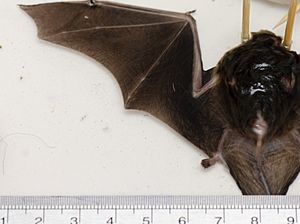Little bent-wing bat facts for kids
Quick facts for kids Little bent-wing bat |
|
|---|---|
 |
|
| Roosting | |
| Conservation status | |
| Scientific classification | |
| Genus: |
Miniopterus
|
| Species: |
australis
|
The little bent-wing bat (Miniopterus australis) is a small bat with long fingers. It is also known as the little long-fingered bat. These bats are part of the Miniopteridae family.
You can find them in several countries. They live in Australia, Indonesia, the Philippines, and Vanuatu. These bats often gather in large groups to rest.
How Scientists Named This Bat
Scientists study and group living things. This process is called taxonomy. The little bent-wing bat was first described in 1858. A scientist named Robert Tomes gave it its scientific name.
Tomes compared this new bat to another bat, Miniopterus blepotis. He looked at their bodies and fur. He also measured their forearms. The new bat was different enough to be its own species.
He named the bat australis. This name means "southern." Tomes first thought the bat only lived in Australia. But he later found specimens from other islands like Timor. So, the name australis became a bit of a misnomer, meaning it wasn't perfectly accurate. But he kept the name to avoid confusion.
Over time, scientists have learned more about these bats. They have made changes to how the species is grouped. This includes identifying different types, called subspecies.
Here are the three main subspecies recognized today:
- Miniopterus australis
-
- Miniopterus australis australis
- Miniopterus australis solomonensis
- Miniopterus australis tibialis
Sometimes, what was once a subspecies can become its own species. This happened with Miniopterus paululus and Miniopterus shortridgei. Scientists keep studying bats to understand them better.
Protecting the Little Bent-Wing Bat
The little bent-wing bat's conservation status was checked in 2008. It was listed as "least concern." This means scientists believe the bat's population is stable. It is not currently at high risk of disappearing.
It can be hard to track bat populations. This is because some bats in Indonesia, the Philippines, and New Guinea islands were sometimes confused with other Miniopterus species. This makes it tricky to know the exact number of little bent-wing bats.
However, these bats live in many different places. This wide distribution helps protect them. Many of these areas are also protected conservation zones.
See also
 In Spanish: Miniopterus australis para niños
In Spanish: Miniopterus australis para niños



